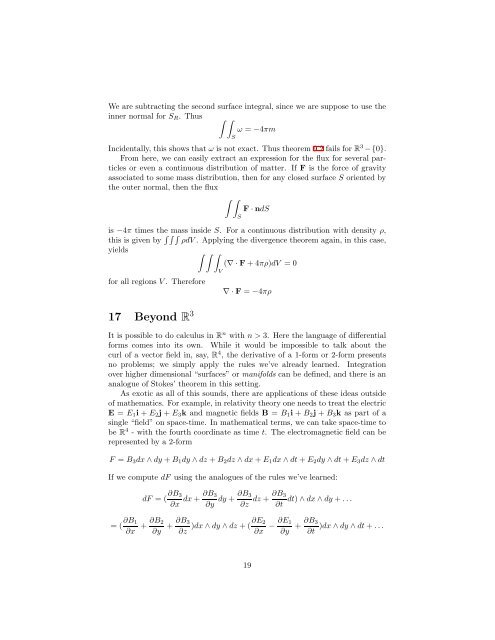Introduction to differential forms
Introduction to differential forms
Introduction to differential forms
You also want an ePaper? Increase the reach of your titles
YUMPU automatically turns print PDFs into web optimized ePapers that Google loves.
We are subtracting the second surface integral, since we are suppose <strong>to</strong> use the<br />
inner normal for S R . Thus ∫ ∫<br />
ω = −4πm<br />
S<br />
Incidentally, this shows that ω is not exact. Thus theorem 9.2 fails for R 3 −{0}.<br />
From here, we can easily extract an expression for the flux for several particles<br />
or even a continuous distribution of matter. If F is the force of gravity<br />
associated <strong>to</strong> some mass distribution, then for any closed surface S oriented by<br />
the outer normal, then the flux<br />
∫ ∫<br />
F · ndS<br />
S<br />
is −4π times the mass inside S. For a continuous distribution with density ρ,<br />
this is given by ∫ ∫ ∫ ρdV . Applying the divergence theorem again, in this case,<br />
yields<br />
∫ ∫ ∫<br />
(∇ · F + 4πρ)dV = 0<br />
for all regions V . Therefore<br />
17 Beyond R 3<br />
V<br />
∇ · F = −4πρ<br />
It is possible <strong>to</strong> do calculus in R n with n > 3. Here the language of <strong>differential</strong><br />
<strong>forms</strong> comes in<strong>to</strong> its own. While it would be impossible <strong>to</strong> talk about the<br />
curl of a vec<strong>to</strong>r field in, say, R 4 , the derivative of a 1-form or 2-form presents<br />
no problems; we simply apply the rules we’ve already learned. Integration<br />
over higher dimensional “surfaces” or manifolds can be defined, and there is an<br />
analogue of S<strong>to</strong>kes’ theorem in this setting.<br />
As exotic as all of this sounds, there are applications of these ideas outside<br />
of mathematics. For example, in relativity theory one needs <strong>to</strong> treat the electric<br />
E = E 1 i + E 2 j + E 3 k and magnetic fields B = B 1 i + B 2 j + B 3 k as part of a<br />
single “field” on space-time. In mathematical terms, we can take space-time <strong>to</strong><br />
be R 4 - with the fourth coordinate as time t. The electromagnetic field can be<br />
represented by a 2-form<br />
F = B 3 dx ∧ dy + B 1 dy ∧ dz + B 2 dz ∧ dx + E 1 dx ∧ dt + E 2 dy ∧ dt + E 3 dz ∧ dt<br />
If we compute dF using the analogues of the rules we’ve learned:<br />
dF = ( ∂B 3<br />
∂x dx + ∂B 3<br />
∂y dy + ∂B 3<br />
∂z dz + ∂B 3<br />
dt) ∧ dx ∧ dy + . . .<br />
∂t<br />
= ( ∂B 1<br />
∂x + ∂B 2<br />
∂y + ∂B 3<br />
∂z )dx ∧ dy ∧ dz + ( ∂E 2<br />
∂x − ∂E 1<br />
∂y + ∂B 3<br />
)dx ∧ dy ∧ dt + . . .<br />
∂t<br />
19








